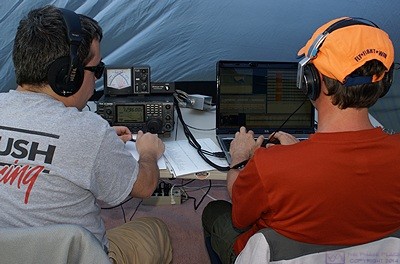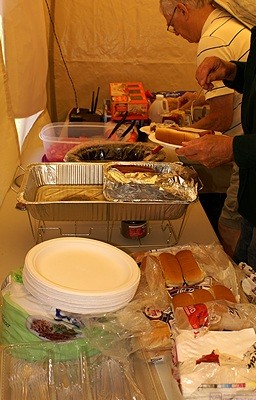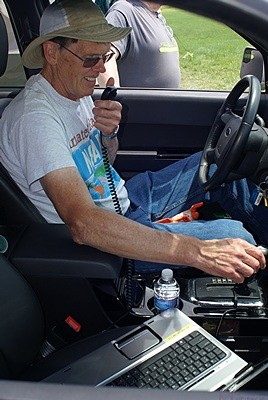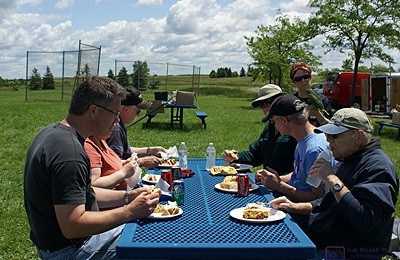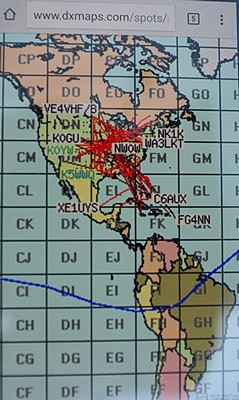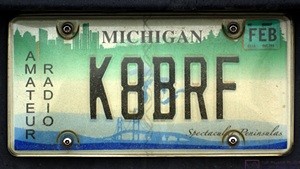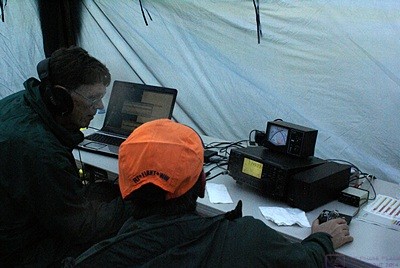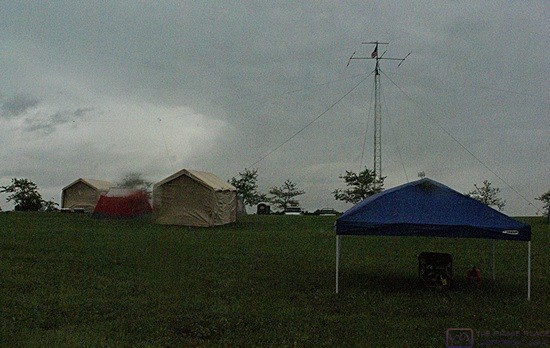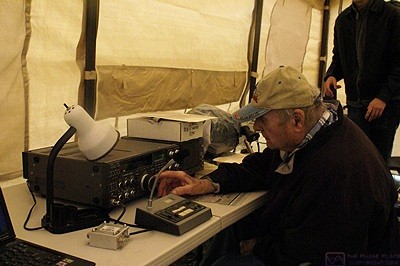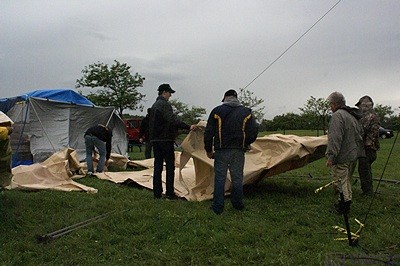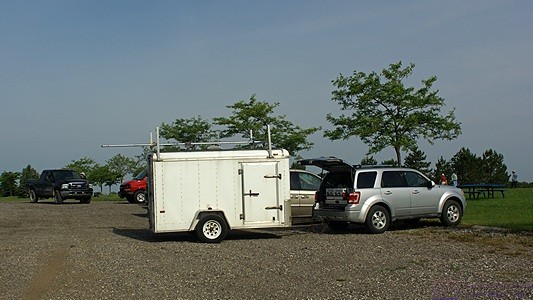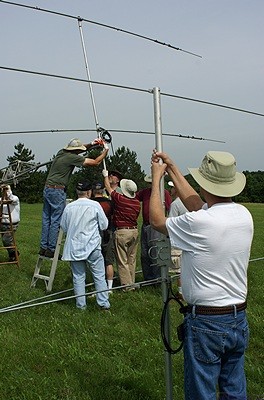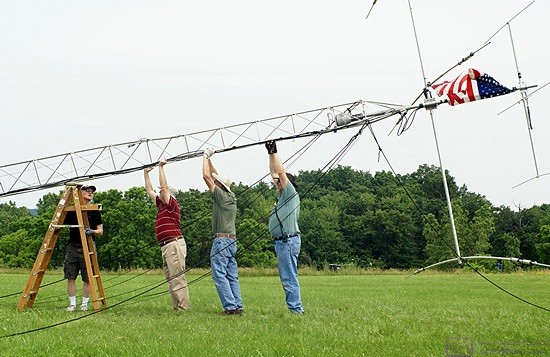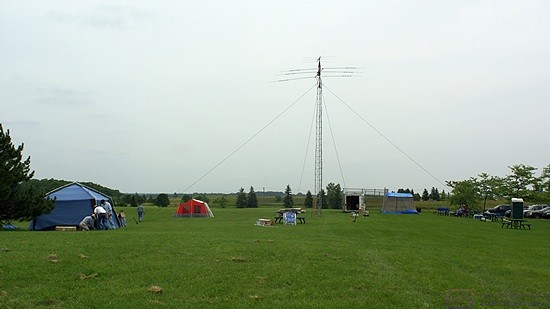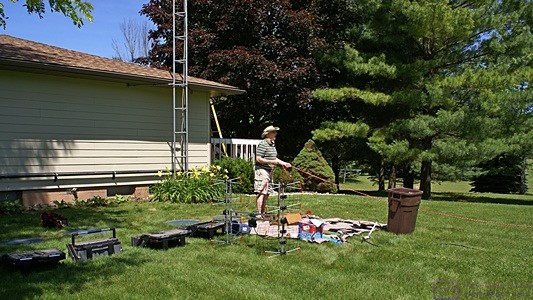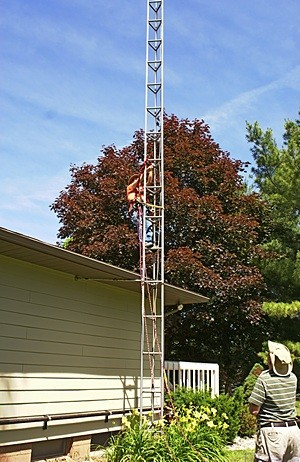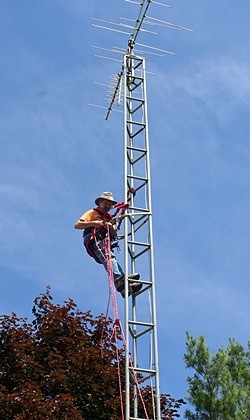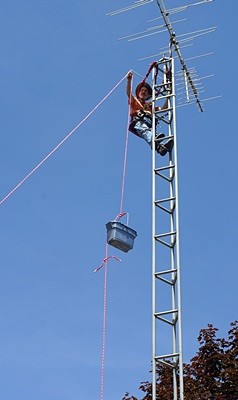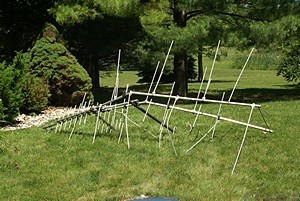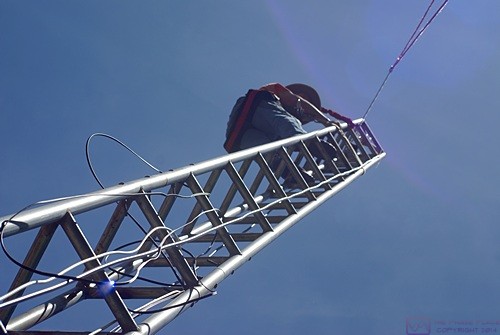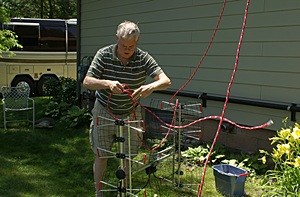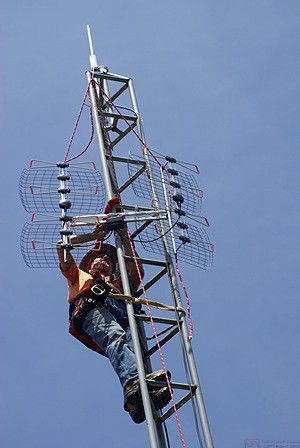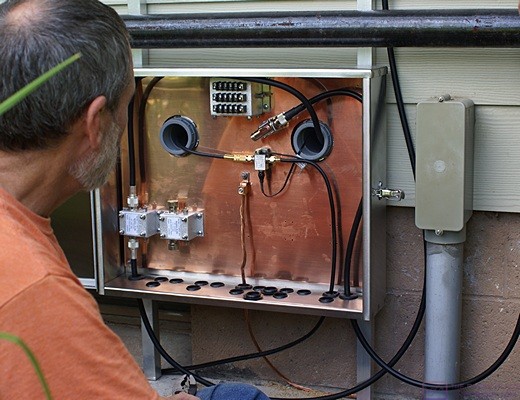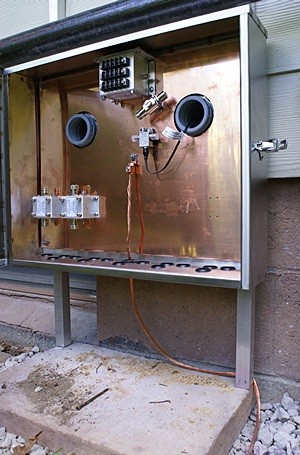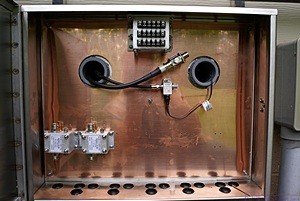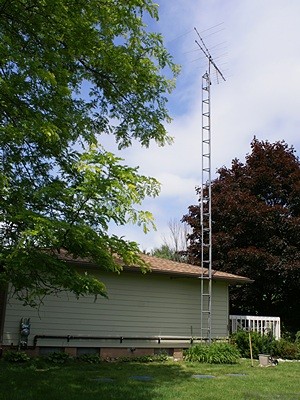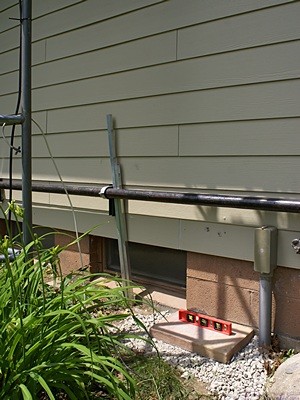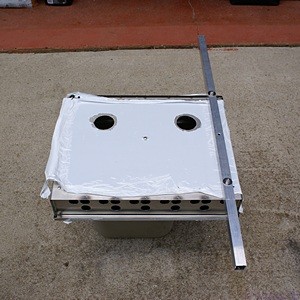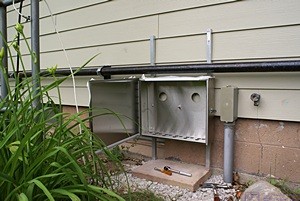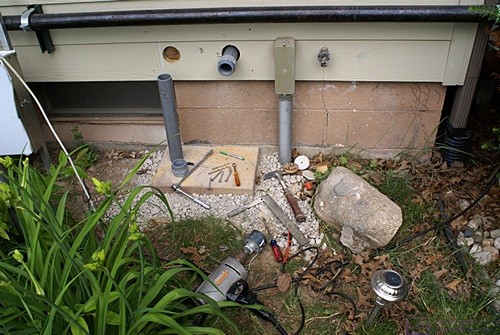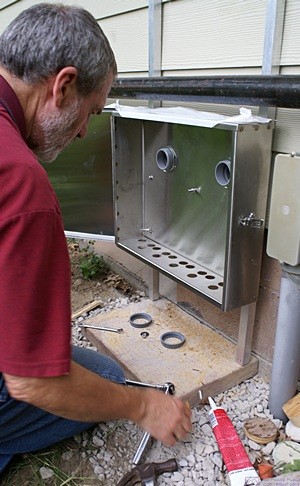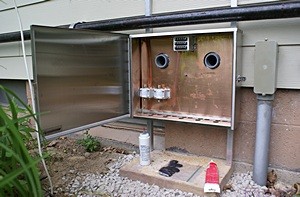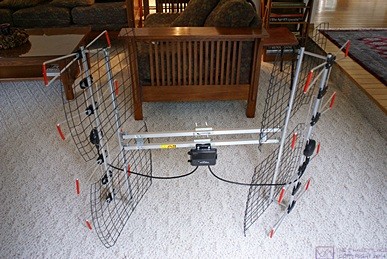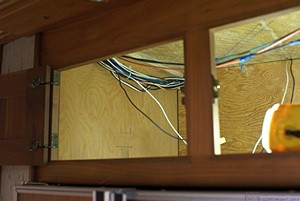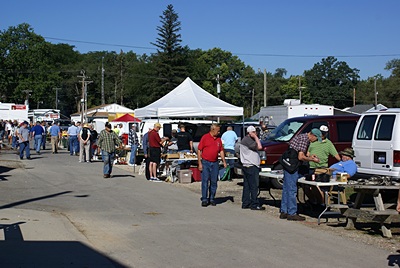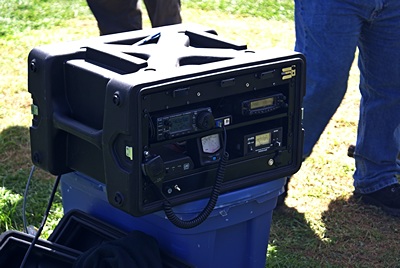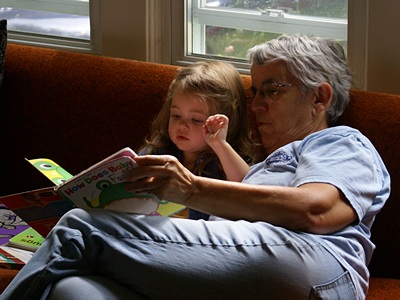2014/10/08 (W) Rally Ho!
Today was a travel day so I had a light breakfast and went to the Small Town Brew for a cup of coffee rather than create a mess making my own. I donated $2 for this cup and did not have a refill so the three cups I consumed over the last two days averaged out to $1 each. I spent most of the morning helping Butch investigate possible routes for the engine preheat plumbing for their new International Thermal Research (ITR) Oasis Combi diesel-fired hydronic heating system. I also adjusted the front bus tire pressures and all four of the car tire pressures.
As noon approached I switched to departure mode. I changed out of my work clothes into something cleaner and more comfortable for driving, finished packing all the stuff I had in the guest bedroom, and loaded it into the bus or the car. I targeted a 1 PM departure. Butch had to go to town so we said farewell until Friday and he took off. By the time I started the bus, pulled it across the street, moved the car over, hooked it up for towing, and checked the lights (with Fonda’s help) it was closer to 1:30 PM than 1:00 PM.
The drive to Elkhart was pleasant and uneventful. The speedometer sat on zero for the first quarter of the trip, bounced around for the second quarter, indicated 85 MPH (max speed) for the third quarter, and settled in to something like the correct speed for the final quarter. This is the way it had behaved for quite some time before it got unplugged so this confirmed that it did not work correctly and needed to be replaced.
I took SR-16 east to US-31 north to US-20 east to CR-17 north. CR-17 becomes MI-217, the Michiana Parkway, which ends at US-12. I took that west to Old M-204 west and followed it past Phoenix Paint back into Indiana where it becomes SR-19 south. I turned east on CR-4 and a mile later turned into the entrance to Elkhart Campground on the south side of the road. This route is at least 15 miles longer than necessary. There is an exit for SR-19 north off of US-20, which is a much more direct route, but requires driving through the heart of Elkhart. There was major road construction on this stretch of SR-19 the last couple of years, including a bridge, with narrow lanes and weight restrictions. That work is all completed, and the road is much better now, but it is still a more urban route with stop lights, turns, and traffic.
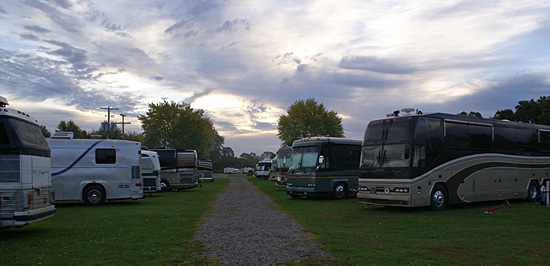
Our coach (front, right) at the FMCA GLCC Surplus & Salvage Rally, Elkhart CG (Elkhart, IN).
I checked in to the campground and then got parked in my assigned site. I was one of the last coaches to arrive. I went through my arrival routine and got the coach setup to use before visiting with fellow GLCC chapter members, some of whom I had never met. I chatted briefly with Michele Henry from Phoenix Paint to confirm her availability to work on a BCM article later in the evening and then went to Martins supermarket to get a salad for dinner. The Martin’s supermarket on SR-19 at CR-4 has a really nice salad bar and I made a big salad with lots of ingredients, all vegan of course.
I took my salad over to the meeting room at 6 PM and had dinner with the group. I was expecting Michele at 6:30 PM so I excused myself and went back to my coach. She showed up a little after 7 PM. We worked until almost 10 PM and managed to go through the entire article. I did not have the photos on my new computer so the selection, processing, and captioning of images will occur later.
2014/10/09 (R) GLCC Surplus and Salvage
I went over for coffee around 8 AM without eating breakfast first. By 9 AM plans had been made for car pools to visit the various RV surplus and salvage businesses in the area. I went back to the coach and had a grapefruit for breakfast and then spent the morning taking care of e-mail and uploading blog posts starting with September 19th.
By noon I was tired of staring at my computer so I turned my attention to the speedometer. After removing the dashboard cover I figured out a socket and ratchet combination that allowed me to remove the two Nylok nuts from the back of the instrument. With the retaining bracket removed the old instrument slipped out the front of the dashboard.
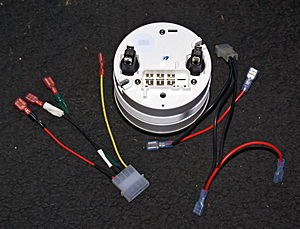
Rear view of new VDO speedometer with custom adaptor cables.
I needed to redo the wiring so I got out my electrical tools. I also tested to voltage to verify that the lighting circuit was 24VDC. It was, and the actual instrument runs on either 12 or 24, so it didn’t care. The existing connectors for the old instrument appeared to be the same 4-pin flat connectors used in personal computers for providing power to hard disk drives, CD drives, and other peripheral components. I checked online and found that Michiana PC was located behind Menard’s a short distance away on the other side of the toll road. I got an adapter cable with the proper connectors on it and then stopped at Menard’s for two different spade connectors. As long as I was out driving around I stopped at Phoenix Paint to pick up coupons for Marco’s Pizza. Since I had to drive past Martin’s on the way back to the campground I stopped and bought groceries.
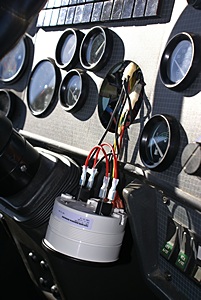
The new VDO speedmeter temporarily connected.
Back at the coach I put the groceries away and got back to work on the speedometer project. I cut leads from the old instrument light wiring as I needed the plug. I then cut the unneeded end off the computer power cable. I wired the lighting connector, spade connectors, and jumpers. I then wired the instrument connector spade lugs to the computer power cable. When all the wiring preparation was done I attached all of the wires except the two for the signal (#16 & #20) and connected the cables to mating chassis connectors. I temporarily set the speedometer in dashboard hole, turn the chassis batteries on, and then turned the light switch on for the dashboard lights. The speedometer lights worked, so I turned the ignition to ‘ON’ without starting the engine. The gauge needle swept up to max and back to zero and the odo displayed 0.0.
I turned the ignition off and disconnected the chassis batteries. I then pulled the instrument out of the dashboard and disconnected the two cables. I got the H3-40 Service Manual out and figured out which wire was the + signal (#16) and which one was the ground (#20). With the cables protruding through the mounting hole from the rear I pushed the spade terminals fully on and reconnected the cables. It was getting to be late afternoon by this point and I decided to leave the finally assembly for tomorrow.
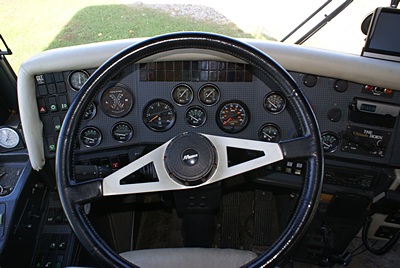
The new VDO speedometer (above & right of center).
I took a shower and shaved and had plenty of hot water as the Aqua-Hot continued to cycle automatically. I prepared an Annie’s Kung Pao noodle bowl for dinner and took it over to the meeting room at 6 PM. I stayed there until 8 PM enjoying bus chat with a small group of chapter members that I know well.
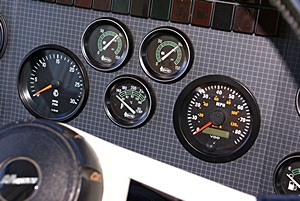
The new VDO speedometer installed in the old hole.
Several members developed problems with their BCM subscriptions over the summer. Pat Lintner gave me a flash drive so I could provide him with the issues he did not receive. I took care of that back at the coach and then continued to upload blog posts and respond to e-mails. I was two days behind on writing blog posts and stayed up until I was caught up which made for a very late night.
2014/10/10 (F) Bus Business
I was up way too late last night catching up on writing drafts of blog posts for the last few days. Linda sent a text message this morning at 6 AM that I read at 7:30 AM letting me know that she was starting the drive to Elkhart. I went over to the meeting room at 8 AM to have coffee and Linda showed up at 9 AM. We visited with the other rally attendees until 10 AM and then went back to our coach to have granola for breakfast.
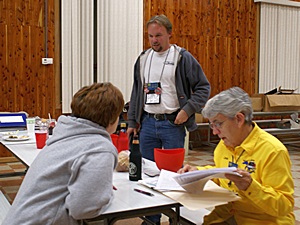
L-to-R: GLCC secretary Tami Bruner, Newsletter editor Scott Bruner, and Treasurer Linda Fay.
At 10:30 AM we drove to Phoenix Paint to deliver some additional copies of Bus Conversion Magazine to Michele and visited with her and Roxanne for a while. Josh was supposed to come look at our coach in the afternoon but had to make an unexpected trip to Chicago. Michele called him and got him rescheduled for tomorrow morning between 9 AM and noon.
Before returning to the campground we stopped at Martin’s supermarket for salad toppings and Radio Shack for a miniature “grain of wheat” light bulb. Radio Shack did not appear to have the bulb I was looking for, but I learned later in the day from Butch that the bulb I need comes with two bare wire leads that fold over to form the contacts.
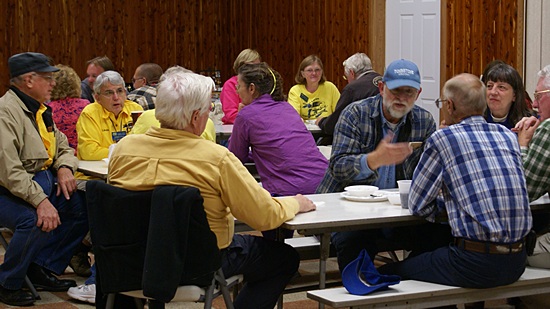
GLCC members gathered for the Friday evening dinner and business meeting.
When we got back to the coach we were going to have lunch but I got busy giving a tour of our bus tour and then touring the late 1990’s MCI 102D Vantare conversion parked next to us. Butch and Fonda arrived (in their car) while all of that was going on. We visited for a while and then they took off for Bontrager’s RV Surplus store.
Many of the GLCC members were away shopping for surplus bargains so we hung around our coach where I worked at my computer and Linda read until she got tired and laid down briefly. I was thinking about lying down too when Pat Lintner stopped by and then Butch/Fonda returned. Before we knew what had happened to the afternoon it was getting to be dinner time. Linda made our dinner salads and we went over to the meeting room a little before 6 PM where we enjoyed our salads in the company of our friends. President Larry Baker conducted a brief business meeting at the conclusion of which Linda was elected to another 2-year term as chapter Treasurer and I was elected to a 2-year term as chapter President. Dean Chipman was elected chapter Vice-President and Tami Bruner was elected chapter Secretary. Pat Lintner stayed on as National Director and Frank Griswold as Alternate National Director.
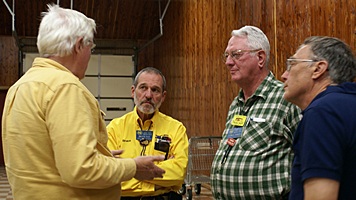
L-to-R: GLCC National Director Pat Lintner talks to newly elected President Bruce Fay and members Charles Martin and Ed Roelle.
Butch and Fonda had to get back to their home to tend to their dogs and left shortly after the voting was concluded. We visited for quite a while with the chapter members before returning to our coach for the evening where we had a glass of wine and went to bed.
2014/10/11 (S) Transfers
The day dawned clear and cold with the morning low temperature in Elkhart at 32 degrees F and frost on the ground and vehicles. We went over for coffee at 8 AM and chatted with fellow chapter members while they had breakfast. Josh was supposed to come look at our coach between 9AM and noon but called to see if late afternoon would be OK. It was fine with me and he agreed to call before he came over.
We returned to our coach and had granola for breakfast. We spent the morning chatting with folks, including the Thornton’s, who stopped by to pay their dues. We had transferred some things to Linda’s car yesterday and transferred some more things this morning. By noon Linda was packed and ready to leave for home. She texted me later to let me know she had stopped in Ann Arbor to visit family and shop at Whole Foods Market before getting back to our house.
Ed Roelle and Marty Caverly came to our coach to listen to our Aqua-Hot. Ed agreed that it should not be producing any visible exhaust after initial startup and thought a likely cause was worn bearings in the blower shaft causing reduced rpm which resulted in reduced air flow which resulted in a rich fuel/air mixture. Ed and Marty both thought the unit sounded normal for a unit with worn bearings.
After looking at the Aqua-Hot I found former chapter President Larry Baker at his coach and we transferred quite a lot of “presidential stuff” to my car. He had been collecting and transporting this “stuff” for the last six years and was all too eager to be rid of it.
Josh called at 3:45 PM to let me know he would be at my coach around 4:45 PM. I made a quick run to Radio Shack to check again for the “grain of wheat” 12 VDC bulb, but they did not have it in stock. Josh arrived a little before 5 PM and we discussed our desired interior renovation for over an hour during which time he also took measurements. By the time we wrapped up our discussion most of the rally attendees had left for dinner at a local restaurant. I called Linda and then had dinner in the coach; a simple green salad, a roll with garlic vegan butter spread, and grapes.
I decided to top off our fresh water tank while there was still some daylight rather than doing it in the morning when it was forecast to be cold. After the tank was full I shut off the water, disconnected and drained the hoses, and stowed them in our fresh water tub. I removed and stowed the pressure regulator and water softener. I then turned each of the three Aqua-Hot loops on, one at a time, to see if I could figure out which circuit included the heat exchangers in the water bay and front storage bay. As best I could determine, the bays are plumbed into the bedroom circuit. I would have preferred to have them plumbed in with the bathroom as we like the bedroom cool for sleeping but want to be able to keep the bays warm enough to avoid freezing.
Scott Bruner and his dad, Richard, were out so I chatted with them about the Aqua-Hot. The Marin’s had a propane camp fire going at their rig next to ours so we went over there to talk for a while. I finally got cold and went in for the night around 9:45 PM. I uploaded the blog posts for the last three days of September and then went to bed and worked on this one.
2014/10/12 (N) Arduino SBC
I got up around 7 AM, got dressed, and spent an hour packing clothes, computers, and other things that would eventually be transferred to the car for the trip home. I went to the meeting room at 8 AM to have one cup of coffee and socialize with the GLCC chapter members who had come over for breakfast. There are special names for breakfast on the last morning of a rally. The one I like best is “hitch up breakfast.” Whether you have a motorhome towing a car or a car/truck pulling a trailer, most RVers have something that has to be hitched up for towing before they can depart. It is also a distant but quaint reference to hitching up a team of horses to a wagon; the original RV having one to six horsepower.
I do not normally have coffee or breakfast on days when I have to drive the bus, but the bus driving portion of my day was only going to be two hours and I would not be pulling out until sometime between 10 and 11 AM. Those who wanted to eat breakfast were done by 9 AM and a crew of women busied themselves cleaning the kitchen and re-packing the supplies. Some of those supplies were destined for my car which was already connected to the back of our bus, so everything got loaded into Pat and Vicky Lintner’s car and they brought it over to my site and I transferred it to my vehicle.
I dumped the waste water holding tanks and stowed the drain hose. By 9:45 AM I was packed and had the bus and car ready to travel except for a few last minute details. I joined a small group of guys for some final conversation as several coaches pulled out. I was in a site directly behind Scott and Tami Bruner and although I could have left before them it was going to be a lot easier to wait until they pulled out, which they did shortly after 10 AM.
I went through the final steps of preparing the car to be towed, turned the coach chassis batteries on, turned the shore power off, disconnected the shore power line, and stowed it. I had opened all the air valves earlier, so I secured all of the bay’s, locked the entrance door (from the inside), and started the engine. While it was building air pressure for the suspension and brakes I called Linda at 10:29 AM to let her know I would be underway shortly and then called Butch. I did not get an answer at Butch and Fonda’s house so I called Butch on his cell phone. He had misunderstood my travel timing and indicated that they might not be home yet when I arrived at their place.
I pulled out of my site at 10:30 AM and reversed the route I had taken on Wednesday, going east on CR-4 (IN) to SR-16 (IN) north, to Old M-204 (MI) eastbound to US-12 (MI) east to M-217 (MI) south (the Michiana Parkway), which became CR-17 (IN) southbound. I left CR-17 and got on westbound US-20 over to US-31 south which I stayed on all the way to SR-16 west towards Twelve Mile. I had a call from Pat Lintner while I was driving regarding the dates for the 2015 Surplus and Salvage rally which will be in mid-September.
I arrived in Twelve Mile at 12:15 PM. I got the car detached and moved it out of the way. While I was doing that Fonda got home from church. After tending to their two dogs (Rascal and Daffy) she helped me back the bus across the street into its parking spot next to their bus. I plugged in the shore power cord to get AC power to the house systems but left the bus systems on temporarily so I could reprogram the new VDO speedometer.
On the drive from Elkhart the speedometer, which had not been calibrated, was indicating just under 8 MPH when I was traveling 60 MPH according to my GPS. That meant the signal from the Allison ATEC transmission computer was putting out fewer pulses per mile than the default speedometer program. For some reason I thought the default might be 200,000 PPM so I computed the ratio between actual and indicated speed and divided 200,000 by that number which gave me 26,316. I programmed that in using the PULSE mode but would not be able to test it until later in the week. If the indicated speed is in the ballpark I will use the ADJUST mode to manually move the pointer to indicate the same speed as the GPS. There is also a CALIBRATE mode that counts the pulses over a one mile distance and then programs that into the instrument. That is the most accurate way to calibrate the speedometer/odometer if you have someplace safe to do it with accurate mile markers.
With that done, I turned off the chassis batteries and the unneeded air circuits in the front bay but left the valve for the engine air accessories turned on. I typically do this when I leave it with someone in case they have to start it. I turned the Aqua-Hot electric heating element on and turned on the bedroom thermostat but set the temperature to a cooler setting. The heat exchangers in the water bay and front storage bay appear to be tied-in with the bedroom heat exchanger.
I transferred stuff from the coach to car the car and by 1:25 PM I was ready to roll, but Butch called and said he was almost back to the house so I waited for him. He had made progress on the Wiremold in the bus kitchen and wanted me to see it. He had also bought a 125 A main lug electrical panel so we discussed the mounting and installation, part of which I will probably work on later this week. He had also received the ITR Oasis Combi unit, so I had to see that too. Fonda built a 3-D cardboard mockup and Butch had it sitting in the water bay where he plans to install the Combi. We will probably do more work on their bus than on ours over the next two weeks, but that’s OK; their bus has more/critical projects at this point than ours and he has helped me a lot with our projects.
I pulled out at 2:05 PM and decided to take a slightly different route home: SR-16 east, US-31 north, US-6 east, I-69 north, M-60 east, I-94 east, M-14 east, US-23 north, M-36 (Nine Mile Road) east, Pontiac Trail north, to Dorothy Street and the SLAARC monthly meeting at the South Lyon Witch’s Hat Depot. I do not usually take US-6 across Indiana although it is a fine road known as the Grand Army of the Republic Highway. It is flatter than US-20 with more towns and associated lower speed limits and stop lights, but it was a nice drive with different scenery.
I arrived at the SLAARC meeting at 7 PM. The business meeting was already concluded and Mike (W8XH) was setting up for his program on the Arduino SBC (single board computer). He bought the experimenters kit and had been playing with it enough to discuss it with the group. Larry (K8UT) discussed the four projects he has built using the Raspberry Pi platform and passed around some of the hardware.
It was 9 PM by the time I finally got to our house. Linda helped me completely unload the car as I had an 8:30 AM service appointment at Brighton Honda and she was leaving before 6 AM for the bakery. She had fixed some strawberries for me and they made a nice treat after a long day of snacking on vegan junk food while driving. I worked for a while on this post before turning in for the night.
2014/10/13 (M) Grain Of Wheat
Linda was up early and out the door at 5:45 AM. I got up a little after 7 AM, started a load of laundry, had a couple of homemade muffins, and got ready to take my car to Brighton Honda for its 90,000 mile service. I got coffee at the Dunkin Donuts across the street from the dealership first and waited in the lounge working on yesterday’s blog post while they worked on my car.
I forgot to specify synthetic oil so the put in regular oil. When the car was done I headed to Novi and immediately noticed a front-end shimmy that was not there when I dropped it off. They had rotated the tires and may not have re-torqued the lug nuts correctly. It also pulled to left, which might be a tire inflation issue. I did not have time to take it back so I will see if it settles out on the drive to Indiana tomorrow. If not, I will need to get at least the front tires/wheels loosened and retightened, and perhaps balanced. Worst case I will have to get the front end aligned.
I found the FedEx/Kinko’s on Grand River Avenue just east of Novi Road and made 10 copies each of two 24″x36″ electrical diagrams; one for the DDEC I ECM (Engine Control Module) and one for the Allison 700 Series ATEC (Automatic Transmission Electronic Control). I folded up an ATEC diagram for me and one for Chuck and rolled up the other eight and put them in a tube for safe keeping. Chuck and I have DDEC II’s controlling our main engines so I rolled the 10 DDEC I diagrams up and put them in a second tube to protect them. By the time I was done it was 10:45 AM and Chuck was at his shop just up the street so I drove there.
He had installed a dual battery maintainer and wanted me to see it. He mounted it on the back wall of the small bay above the passenger side drive tire of their bus which got it close enough to the chassis batteries (in a tray above the tag tire) for the built-in charging cables to reach the correct battery terminals. He was still pondering where to tie in the AC power source so we discussed some alternatives. He had also put the red covers on the bulbs in his new VDO speedometer so I got to see that. Ours are white for now but most of the dash lighting is green. The red makes the speedo stand out, but if I change ours from white it will likely be to green. Chuck had a supply of spare 12VDC, 1.2W “grain of wheat” light bulbs that are used in our illuminated switches and let me have four. Our Aqua-Hot switch does not currently light up when it is turned on.
After checking out his projects we went to the Panera at Grand River Avenue and Novi Road for lunch. We had a good chat and solved all of the world’s problems so he went back to the shop to find some new ones and I went home to take care of chores. I continued doing laundry and worked on the SLAARC WordPress website setting up user accounts for several new club members.
Linda got home around 5:30 PM and got busy making dinner. She started with a nice salad featuring a ginger dressing. Dinner was 45 minutes later; a baked potato with Brussels sprouts on the side, a glass of Leelanau Cellars Winter White with Peach wine, and grapes for dessert. She worked on something for Butch while the potatoes baked and I worked on e-mail.
We were both tired after dinner but took some time to sort and fold the laundry from which I selected and packed the clothes I will need for the next 10 days. We were tired and turned in after that. I had received an e-mail from Butch with seven photos attached of the place we are considering staying in Quartzite, AZ. It took us a while, but we eventually matched them up with the correct lot on the Google Maps satellite view. It is not the corner lot as Butch and I previously thought, but the 3rd lot north of Kenoyer on the east side of N Lollipop Lane. With that issue resolved we turned out the lights and went to sleep.
2014/10/14 (T) A Crowning Achievement
Linda was up at 5:15 AM again and out the door on the way to the bakery at 5:45 AM. At this hour of the morning she has clear sailing all the way to Hamtramck which is much less stressful than the parking lot that develops on I-96 inbound just a short time later. I was up at 7:15 AM, showered, and started gathering and organizing all of the stuff that I had to load into the car for the trip back to Indiana.
Keith showed up at 9 AM to cut the grass as I was loading my car. He was rained out yesterday and today was not looking too good either but he figured he would have a go at it. I wrote out his check and paid him in advance as I would be gone long before he finished. I had time for a cup of green tea and pulled out of my driveway at 9:30 AM.
My first destination was Gusfa Dental in Dearborn, Michigan where I had an 11 AM appointment. Dr. Steve and his assistant, Margaret, installed my new permanent ceramic crown on the upper right tooth that had a root canal procedure in mid-September. The crown fit almost perfectly and only required a little modification on the surfaces that abut the two teeth immediately adjacent. The bite was just right. Gusfa Dental is definitely not the cheapest clinic around, but the work is top notch and they have been our dentists for almost 40 years.
I was done and out the door at 11:20 AM and headed directly for Twelve Mile, Indiana. The drive was wet but uneventful. Given my starting point in Dearborn I changed my route yet again, this time taking I-94 west to M-60 southwest to I-69 south to the I-80/90 Indiana Toll Road west to exit 92 at SR-19 (IN) in Elkhart. From there I headed south on SR-19 and wound my way slowly through Elkhart until I picked up US-20 westbound on the south side of Elkhart. From US-20 I picked up US-31 south and exited at IN-25 south of Rochester, Indiana where I bought some groceries at the Kroger store. I texted Linda and then called Butch. As I was getting ready to head south on IN-25 I got a call from Michele Henry of Phoenix Paint with some questions about the Zip Dee awnings we had installed on our coach after she finished painting it. I took IN-25 as far south as Fulton and turned east onto a small farm road that took me to Meridian then south to SR-16 and east to Twelve Mile.
While driving down Meridian I saw one of the most intense and perfect rainbows I have ever experienced. It was deeply colored, very clear, and an entire semicircle was visible. A second rainbow, fainter and partial, formed above the first one on the right (south) end. The sky was very dark to the east with bright, low sun from the west. The trees were blazing with color, intensified by the rains, and white farm houses glistened as if they had just been freshly painted. It was spectacular but I was not able to get a photo of it. I arrived in Twelve Mile at 5 PM and immediately unloaded and stored my groceries. I then brought my clothes and technology items into the house and put them in the guest bedroom where I stay when I am here.
Butch needed some parts for various bus projects so I drove us to Home Depot in Logansport. One the drive in he got a call from his brother Tom. He had a problem with his air compressor and wanted Butch to look at it so we went there after our stop at Home Depot, with a stop at the local Mobil station so I could fill the fuel tank in my car. Butch quickly made a tentative diagnosis of the compressor problem as the starting capacitor and/or switch. Tom and Butch did some pondering about details of Tom’s project in which he is converting the front half of a Crosley sedan into a trailer.
We visited for a while back at the house and looked up the grain of wheat bulb I needed for the illuminated switches in the H3-40. Napa Auto Parts shows it in their automotive lighting catalog as a #37, 12 VDC, 1.26 W, wedge based. Butch looked online and found a place (Bulbtown) that sells them for $0.42 each. Orders over $50 get free shipping and handling so we discussed doing a bulb inventory of each bus and then pooling our orders.
I spent a few minutes showing Butch how the photos that Joe sent of the lot in Quartzite matched up with the Google Maps/Earth satellite and Streetview images. By the time we were done with that it was late and we all turned in for the night.
2014/10/15 (W) MC-9 AC Wiring
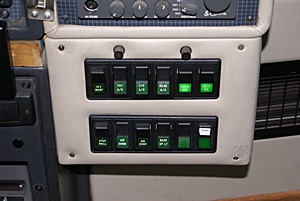
Cockpit house systems switch panel.
Butch bought a brass nipple (NPT) last night to thread into the fitting on his fresh water tank but the fit was still too loose. He needed the nipple in order to put the fresh water tank back in the bus. Between that and the really soupy 54 degree F weather it was obvious that today was not going to be an outside work day. I suggested that we work on the AC wiring on their bus instead—a nice inside project—after breakfast.
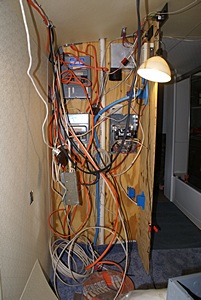
House electrical closet in Butch & Fonda’s MC-9 before rewiring.
I had homemade granola with fresh blueberries and soy milk, a glass of orange juice, and two cups of Seattle Blend 1/2 decaf coffee. While the coffee was brewing I unscrewed the switch panel with the Aqua-Hot switch and replaced the “grain of wheat” bulbs in the Aqua-Hot switch and the Engine Preheat switch. We then got to work on the AC (house) wiring for their bus conversion.
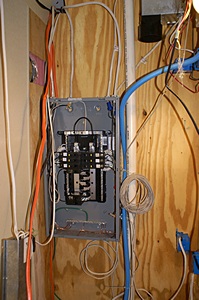
New 20-slot AC panel for inverter circuits.
The bus had three small main lug load centers, with six circuit breakers each, mounted in a future closet in the bedroom. We ran an extension cord through the passenger side rear slider window to power a work light, disconnected the shoreline, and switched off the inverter. I then removed the three panels one at a time, labeling each cable as I pulled it out. With all of the old panels out we mounted the new 20-position panel box for use with the inverter circuit. I spent the rest of the work day, except for a lunch break, pulling old and new electrical cable into the new box and making the connections to the ground bar, neutral bus, and the GFCI circuit breakers for all of the circuits that will be fed by the inverter. We tied in the main AC power to the inverter AC input and checked that all of the circuits worked as planned, which they did. I will mount two of the smaller boxes tomorrow and pull the cables for the shorepower/generator only circuits into those boxes.
We quit working for the day at 7:30 PM and I washed up before making my dinner. I had a nice salad with “power greens” and various toppings and leftover Koshary. Yum. I drew a glass of Moscato, did the dishes, and went back to the house. I had a text and an e-mail from Linda so I replied to those. We were all tired and turned in a little after 9 PM.
